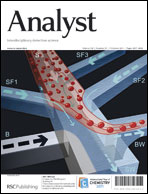An ultra-sensitive DNA assay based on single-molecule detection coupled with hybridization accumulation and its application†
Abstract
An ultra-sensitive assay for quantification of DNA based on single-molecule detection coupled with hybridization accumulation was developed. In this assay, target DNA (tDNA) in solution was accumulated on a silanized substrate blocked with


 Please wait while we load your content...
Please wait while we load your content...